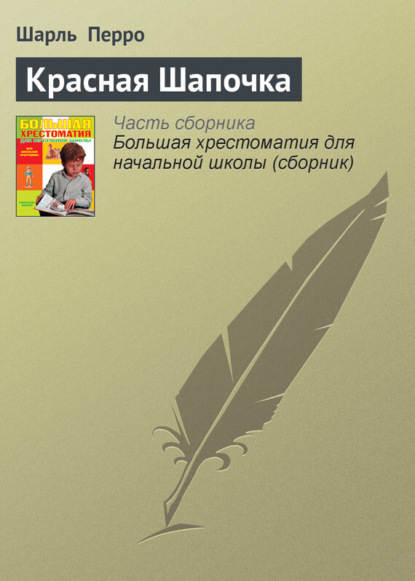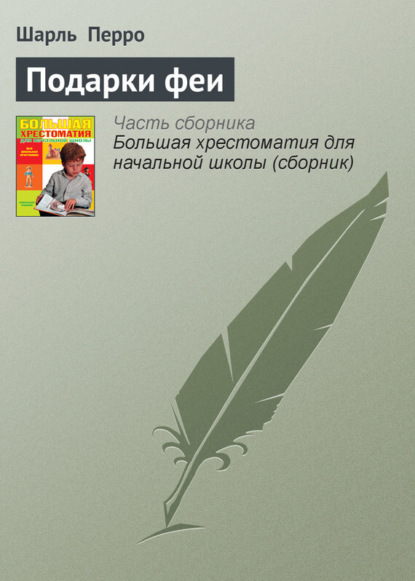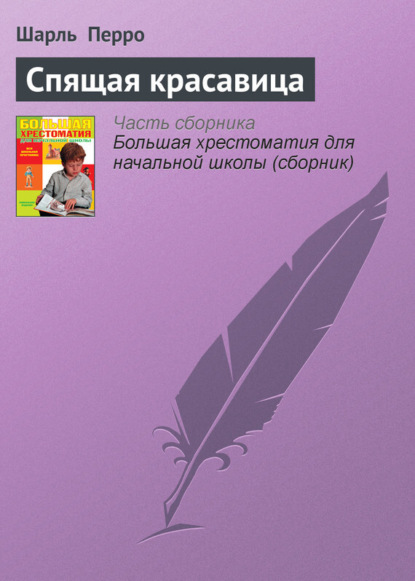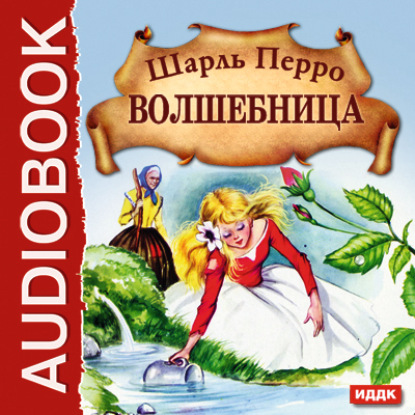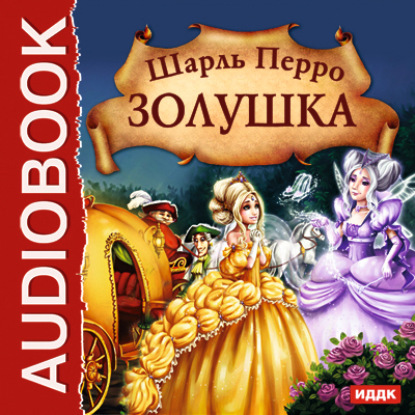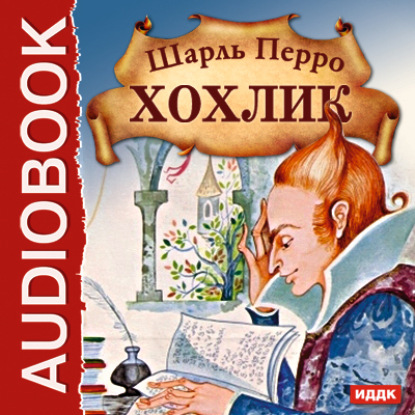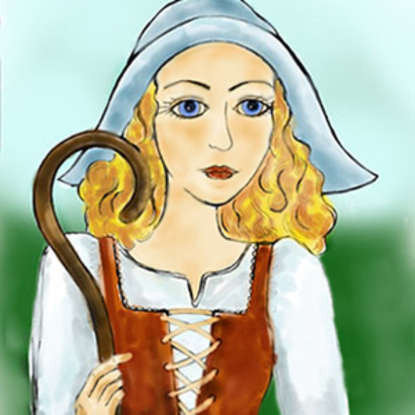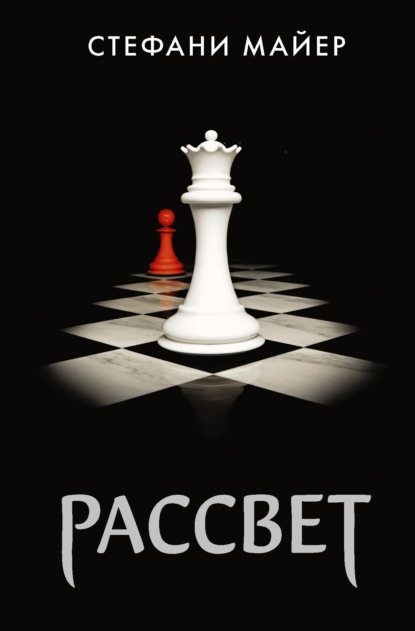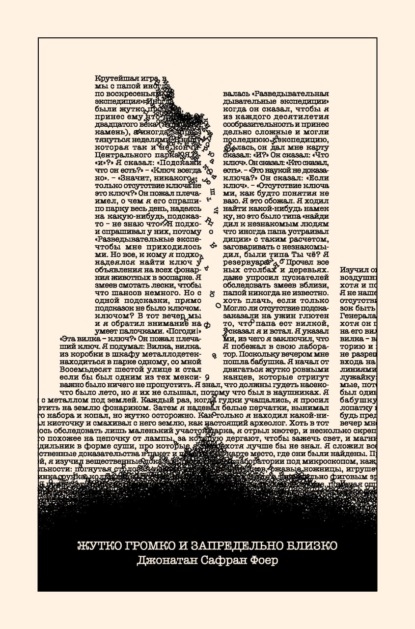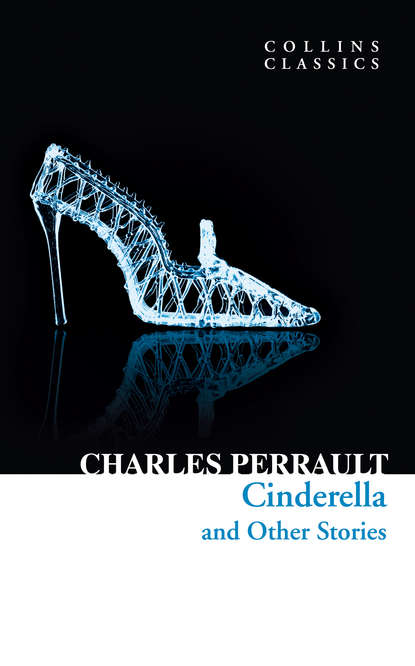
Текст
отзывы: 0 | рейтинг: 0
Cinderella and Other Stories
Язык:
Английский
Тип:
Текст
Год издания:
2019
Полная версия
Полная версия
Cinderella and Other Stories
Charles Perrault
HarperCollins is proud to present its incredible range of best-loved, essential classics.‘She promised her godmother that she would not fail to leave the ball before midnight, and away she went, beside herself with delight…’Charles Perrault’s time-honoured stories have been passed down from the seventeenth century to the present day, giving us the classic fairy tales that people of all ages know and adore: Cinderella, with the glass slipper that will fit her foot alone; the princess who is cursed to sleep for a hundred years until true love’s kiss wakes her; Little Red Riding Hood and the wolf, and many, many more.Like the Brothers Grimm after him, Perrault took childhood fears and turned them into inspiriting fantasies. Full of humanity and a surprising wit, the impact these fables has had on imaginations young and old cannot be overstated.
CINDERELLA AND OTHER STORIES
Charles Perrault
Translated by A. E. Johnson
Copyright (#u25c46fb1-697b-5171-9565-d509e0f33e37)
William Collins
An imprint of HarperCollinsPublishers
1 London Bridge Street,
London SE1 9GF
WilliamCollinsBooks.com (http://WilliamCollinsBooks.com)
This eBook edition published by William Collins in 2015
Life & Times section © HarperCollinsPublishers Ltd
Silvia Crompton asserts her moral right as author of the Life & Times section
Classic Literature: Words and Phrases adapted from
Collins English Dictionary
Cover by e-Digital Design
Cover image: Glass slipper © R-O-M-A / Shutterstock
A catalogue record for this book is available from the British Library
All rights reserved under International and Pan-American Copyright Conventions. By payment of the required fees, you have been granted the non-exclusive, non-transferable right to access and read the text of this e-book on-screen. No part of this text may be reproduced, transmitted, down-loaded, decompiled, reverse engineered, or stored in or introduced into any information storage and retrieval system, in any form or by any means, whether electronic or mechanical, now known or hereinafter invented, without the express written permission of HarperCollins
Source ISBN: 9780008147457
Ebook Edition © August 2015 ISBN: 9780008147464
Version: 2015-07-21
CONTENTS
Cover (#u03a8100e-123f-5a8c-a261-3e02e004ff01)
Title Page (#u0cc180a5-2211-5d55-826a-1036fe36d1e3)
Copyright
History of Collins
Life & Times
The Sleeping Beauty in the Wood
Puss in Boots
Little Tom Thumb
The Fairies
Ricky of the Tuft
Cinderella, or the Little Glass Slipper
Little Red Riding Hood
Blue Beard
The Ridiculous Wishes
Donkey-Skin
Classic Literature: Words and Phrases
About the Publisher
History of Collins (#u25c46fb1-697b-5171-9565-d509e0f33e37)
In 1819, millworker William Collins from Glasgow, Scotland, set up a company for printing and publishing pamphlets, sermons, hymn books, and prayer books. That company was Collins and was to mark the birth of HarperCollins Publishers as we know it today. The long tradition of Collins dictionary publishing can be traced back to the first dictionary William published in 1824, Greek and English Lexicon. Indeed, from 1840 onwards, he began to produce illustrated dictionaries and even obtained a licence to print and publish the Bible.
Soon after, William published the first Collins novel, Ready Reckoner; however, it was the time of the Long Depression, where harvests were poor, prices were high, potato crops had failed, and violence was erupting in Europe. As a result, many factories across the country were forced to close down and William chose to retire in 1846, partly due to the hardships he was facing.
Aged 30, William’s son, William II, took over the business. A keen humanitarian with a warm heart and a generous spirit, William II was truly ‘Victorian’ in his outlook. He introduced new, up-to-date steam presses and published affordable editions of Shakespeare’s works and ThePilgrim’s Progress, making them available to the masses for the first time. A new demand for educational books meant that success came with the publication of travel books, scientific books, encyclopedias, and dictionaries. This demand to be educated led to the later publication of atlases, and Collins also held the monopoly on scripture writing at the time.
In the 1860s Collins began to expand and diversify and the idea of ‘books for the millions’ was developed. Affordable editions of classical literature were published, and in 1903 Collins introduced 10 titles in their Collins Handy Illustrated Pocket Novels. These proved so popular that a few years later this had increased to an output of 50 volumes, selling nearly half a million in their year of publication. In the same year, The Everyman’s Library was also instituted, with the idea of publishing an affordable library of the most important classical works, biographies, religious and philosophical treatments, plays, poems, travel, and adventure. This series eclipsed all competition at the time, and the introduction of paperback books in the 1950s helped to open that market and marked a high point in the industry.
HarperCollins is and has always been a champion of the classics, and the current Collins Classics series follows in this tradition – publishing classical literature that is affordable and available to all. Beautifully packaged, highly collectible, and intended to be reread and enjoyed at every opportunity.
Life & Times (#u25c46fb1-697b-5171-9565-d509e0f33e37)
Cinderella and Other Stories
The fairy tales we all grew up with are so familiar to us that it is hard to imagine someone, somewhere, having sat down and actually written them. Perhaps thanks to their modern-day Hollywood adaptations, we barely think of them as books at all. But although tales similar to Cinderella, Sleeping Beauty and Puss in Boots have existed in European oral storytelling traditions for centuries, it took one man, very late in his life, to update them for the modern age and record them for posterity. That man was Charles Perrault.
An Auspicious Start
There is relatively little to be said about Charles Perrault’s early years, perhaps because he had a considerably more fortunate childhood than most famous writers. Perrault was born in Paris in 1628, the fifth son of wealthy parents. He was sent to a prestigious school and did well there, becoming, in his own words, ‘one of the best students in my class’. ‘I took so much pleasure in class debates,’ he later recalled in his memoirs, ‘that I enjoyed the days we went to school as much as the holidays.’ Around the age of fifteen, he left school to study independently for a few years — among other subjects, poetry — during which he also found the time to put together a burlesque translation of a portion of Virgil’s Aeneid.
But writing was not the career he — or, more to the point, his father — had in mind. Aged twenty-three, and after a fleeting attendance at the University of Orléans (‘They were not … strict … in granting degrees’), Perrault became a lawyer. It was a short-lived endeavour and he never settled into it, abandoning the profession in 1654 to become a government clerk under his brother Pierre. Finding his new job ‘not very demanding’, Perrault took to visiting libraries and reading poetry, and was inspired to write a poem, ‘Le Portrait d’Iris’, which was published to positive reviews in 1659.
Although he continued to write and publish poetry, he spent the late 1650s and early 1660s restoring and redesigning a large family estate, as a result of which he came to the attention of Jean-Baptiste Colbert, Louis XIV’s superintendent of buildings. Under Colbert’s patronage, Perrault rose to a position of significant influence in the royal court, even able to appoint his own brother Claude to design the east wing of the Louvre. He took to commemorating notable royal events in verse.
The Quarrel of the Ancients and the Moderns
By 1671, Perrault was esteemed enough in Parisian society to be elected to the prestigious Académie française, an elite authority established to maintain correct usage of the French language. In this role, he became deeply involved in an academic debate that began as a difference of artistic opinion and quickly developed into a fierce, decades-long war of words between France’s most eminent thinkers.
The subject of the debate sounds almost trivial now, but in the late seventeenth century it challenged the very foundations of the Académie française. It centred on a long-held view among academics that no contemporary writer could ever match the talent and excellence of his Classical Greek and Roman predecessors. Perrault was one of a few members who thought differently, and in 1674, after his less enlightened colleagues mounted a denunciation of opera — then a relatively new form of music — he published Critique de l’Opéra, a spirited defence that made unfavourable comparisons with ancient works.
The Académie quickly split into two factions, the Anciens (among them Nicolas Boileau, Jean Racine and Jean de la Fontaine) and the Modernes (led by Perrault), who took to publishing and counter-publishing tracts against the other’s thinking. Perrault’s Le Siècle de Louis le Grand (The Century of Louis the Great), published in 1687, was one of the key cases for the prosecution, establishing the Modernes’ arguably immodest viewpoint that they were living and writing in times of artistic excellence.
The debate continued into the early years of the eighteenth century but Perrault and his supporters ultimately won the day, setting the scene for France to lead the world in literary and artistic experimentation.
Fabulous Beasts
Charles Perrault
HarperCollins is proud to present its incredible range of best-loved, essential classics.‘She promised her godmother that she would not fail to leave the ball before midnight, and away she went, beside herself with delight…’Charles Perrault’s time-honoured stories have been passed down from the seventeenth century to the present day, giving us the classic fairy tales that people of all ages know and adore: Cinderella, with the glass slipper that will fit her foot alone; the princess who is cursed to sleep for a hundred years until true love’s kiss wakes her; Little Red Riding Hood and the wolf, and many, many more.Like the Brothers Grimm after him, Perrault took childhood fears and turned them into inspiriting fantasies. Full of humanity and a surprising wit, the impact these fables has had on imaginations young and old cannot be overstated.
CINDERELLA AND OTHER STORIES
Charles Perrault
Translated by A. E. Johnson
Copyright (#u25c46fb1-697b-5171-9565-d509e0f33e37)
William Collins
An imprint of HarperCollinsPublishers
1 London Bridge Street,
London SE1 9GF
WilliamCollinsBooks.com (http://WilliamCollinsBooks.com)
This eBook edition published by William Collins in 2015
Life & Times section © HarperCollinsPublishers Ltd
Silvia Crompton asserts her moral right as author of the Life & Times section
Classic Literature: Words and Phrases adapted from
Collins English Dictionary
Cover by e-Digital Design
Cover image: Glass slipper © R-O-M-A / Shutterstock
A catalogue record for this book is available from the British Library
All rights reserved under International and Pan-American Copyright Conventions. By payment of the required fees, you have been granted the non-exclusive, non-transferable right to access and read the text of this e-book on-screen. No part of this text may be reproduced, transmitted, down-loaded, decompiled, reverse engineered, or stored in or introduced into any information storage and retrieval system, in any form or by any means, whether electronic or mechanical, now known or hereinafter invented, without the express written permission of HarperCollins
Source ISBN: 9780008147457
Ebook Edition © August 2015 ISBN: 9780008147464
Version: 2015-07-21
CONTENTS
Cover (#u03a8100e-123f-5a8c-a261-3e02e004ff01)
Title Page (#u0cc180a5-2211-5d55-826a-1036fe36d1e3)
Copyright
History of Collins
Life & Times
The Sleeping Beauty in the Wood
Puss in Boots
Little Tom Thumb
The Fairies
Ricky of the Tuft
Cinderella, or the Little Glass Slipper
Little Red Riding Hood
Blue Beard
The Ridiculous Wishes
Donkey-Skin
Classic Literature: Words and Phrases
About the Publisher
History of Collins (#u25c46fb1-697b-5171-9565-d509e0f33e37)
In 1819, millworker William Collins from Glasgow, Scotland, set up a company for printing and publishing pamphlets, sermons, hymn books, and prayer books. That company was Collins and was to mark the birth of HarperCollins Publishers as we know it today. The long tradition of Collins dictionary publishing can be traced back to the first dictionary William published in 1824, Greek and English Lexicon. Indeed, from 1840 onwards, he began to produce illustrated dictionaries and even obtained a licence to print and publish the Bible.
Soon after, William published the first Collins novel, Ready Reckoner; however, it was the time of the Long Depression, where harvests were poor, prices were high, potato crops had failed, and violence was erupting in Europe. As a result, many factories across the country were forced to close down and William chose to retire in 1846, partly due to the hardships he was facing.
Aged 30, William’s son, William II, took over the business. A keen humanitarian with a warm heart and a generous spirit, William II was truly ‘Victorian’ in his outlook. He introduced new, up-to-date steam presses and published affordable editions of Shakespeare’s works and ThePilgrim’s Progress, making them available to the masses for the first time. A new demand for educational books meant that success came with the publication of travel books, scientific books, encyclopedias, and dictionaries. This demand to be educated led to the later publication of atlases, and Collins also held the monopoly on scripture writing at the time.
In the 1860s Collins began to expand and diversify and the idea of ‘books for the millions’ was developed. Affordable editions of classical literature were published, and in 1903 Collins introduced 10 titles in their Collins Handy Illustrated Pocket Novels. These proved so popular that a few years later this had increased to an output of 50 volumes, selling nearly half a million in their year of publication. In the same year, The Everyman’s Library was also instituted, with the idea of publishing an affordable library of the most important classical works, biographies, religious and philosophical treatments, plays, poems, travel, and adventure. This series eclipsed all competition at the time, and the introduction of paperback books in the 1950s helped to open that market and marked a high point in the industry.
HarperCollins is and has always been a champion of the classics, and the current Collins Classics series follows in this tradition – publishing classical literature that is affordable and available to all. Beautifully packaged, highly collectible, and intended to be reread and enjoyed at every opportunity.
Life & Times (#u25c46fb1-697b-5171-9565-d509e0f33e37)
Cinderella and Other Stories
The fairy tales we all grew up with are so familiar to us that it is hard to imagine someone, somewhere, having sat down and actually written them. Perhaps thanks to their modern-day Hollywood adaptations, we barely think of them as books at all. But although tales similar to Cinderella, Sleeping Beauty and Puss in Boots have existed in European oral storytelling traditions for centuries, it took one man, very late in his life, to update them for the modern age and record them for posterity. That man was Charles Perrault.
An Auspicious Start
There is relatively little to be said about Charles Perrault’s early years, perhaps because he had a considerably more fortunate childhood than most famous writers. Perrault was born in Paris in 1628, the fifth son of wealthy parents. He was sent to a prestigious school and did well there, becoming, in his own words, ‘one of the best students in my class’. ‘I took so much pleasure in class debates,’ he later recalled in his memoirs, ‘that I enjoyed the days we went to school as much as the holidays.’ Around the age of fifteen, he left school to study independently for a few years — among other subjects, poetry — during which he also found the time to put together a burlesque translation of a portion of Virgil’s Aeneid.
But writing was not the career he — or, more to the point, his father — had in mind. Aged twenty-three, and after a fleeting attendance at the University of Orléans (‘They were not … strict … in granting degrees’), Perrault became a lawyer. It was a short-lived endeavour and he never settled into it, abandoning the profession in 1654 to become a government clerk under his brother Pierre. Finding his new job ‘not very demanding’, Perrault took to visiting libraries and reading poetry, and was inspired to write a poem, ‘Le Portrait d’Iris’, which was published to positive reviews in 1659.
Although he continued to write and publish poetry, he spent the late 1650s and early 1660s restoring and redesigning a large family estate, as a result of which he came to the attention of Jean-Baptiste Colbert, Louis XIV’s superintendent of buildings. Under Colbert’s patronage, Perrault rose to a position of significant influence in the royal court, even able to appoint his own brother Claude to design the east wing of the Louvre. He took to commemorating notable royal events in verse.
The Quarrel of the Ancients and the Moderns
By 1671, Perrault was esteemed enough in Parisian society to be elected to the prestigious Académie française, an elite authority established to maintain correct usage of the French language. In this role, he became deeply involved in an academic debate that began as a difference of artistic opinion and quickly developed into a fierce, decades-long war of words between France’s most eminent thinkers.
The subject of the debate sounds almost trivial now, but in the late seventeenth century it challenged the very foundations of the Académie française. It centred on a long-held view among academics that no contemporary writer could ever match the talent and excellence of his Classical Greek and Roman predecessors. Perrault was one of a few members who thought differently, and in 1674, after his less enlightened colleagues mounted a denunciation of opera — then a relatively new form of music — he published Critique de l’Opéra, a spirited defence that made unfavourable comparisons with ancient works.
The Académie quickly split into two factions, the Anciens (among them Nicolas Boileau, Jean Racine and Jean de la Fontaine) and the Modernes (led by Perrault), who took to publishing and counter-publishing tracts against the other’s thinking. Perrault’s Le Siècle de Louis le Grand (The Century of Louis the Great), published in 1687, was one of the key cases for the prosecution, establishing the Modernes’ arguably immodest viewpoint that they were living and writing in times of artistic excellence.
The debate continued into the early years of the eighteenth century but Perrault and his supporters ultimately won the day, setting the scene for France to lead the world in literary and artistic experimentation.
Fabulous Beasts
Другие книги автора:
Популярные книги





